Analyzing Digital Disruption in Fashion: ICT Professional Practice
VerifiedAdded on 2023/06/14
|10
|2331
|366
Case Study
AI Summary
This case study report analyzes the impact of digital disruption on the fashion industry using a work-centered analysis (WCA) approach. It examines the industry before and after digital disruption, focusing on customers, products, and processes. The report identifies both positive impacts, such as improved customer interaction and virtual change rooms, and negative impacts, including increased competition and transparency challenges for retailers. It provides recommendations for fashion companies to understand and adapt to digital disruption, emphasizing the need for detailed market insights, business analysis, and monitoring of new trends. The report concludes that digital disruption significantly affects the fashion industry, requiring companies to adopt strategic measures for economic development and stay competitive.
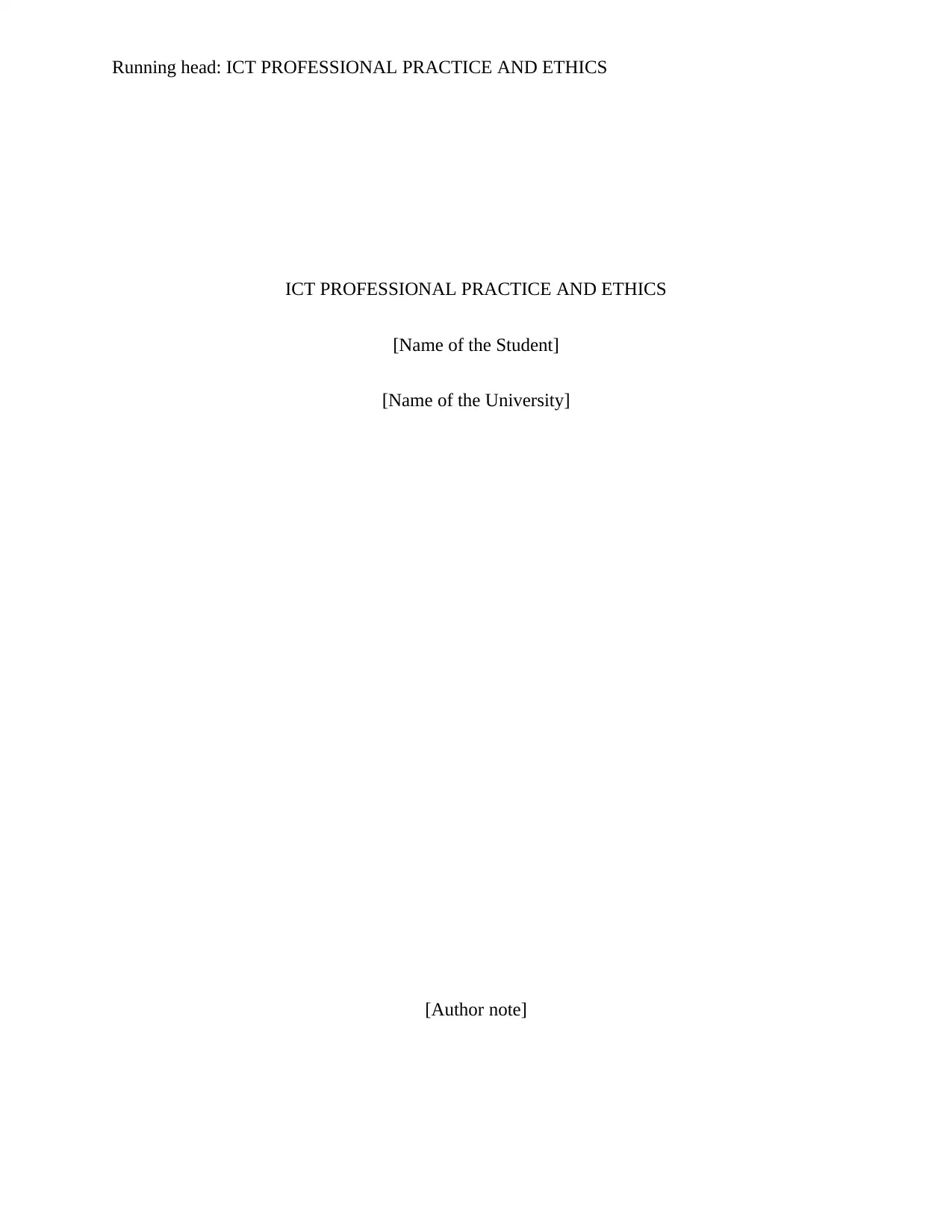
Running head: ICT PROFESSIONAL PRACTICE AND ETHICS
ICT PROFESSIONAL PRACTICE AND ETHICS
[Name of the Student]
[Name of the University]
[Author note]
ICT PROFESSIONAL PRACTICE AND ETHICS
[Name of the Student]
[Name of the University]
[Author note]
Paraphrase This Document
Need a fresh take? Get an instant paraphrase of this document with our AI Paraphraser
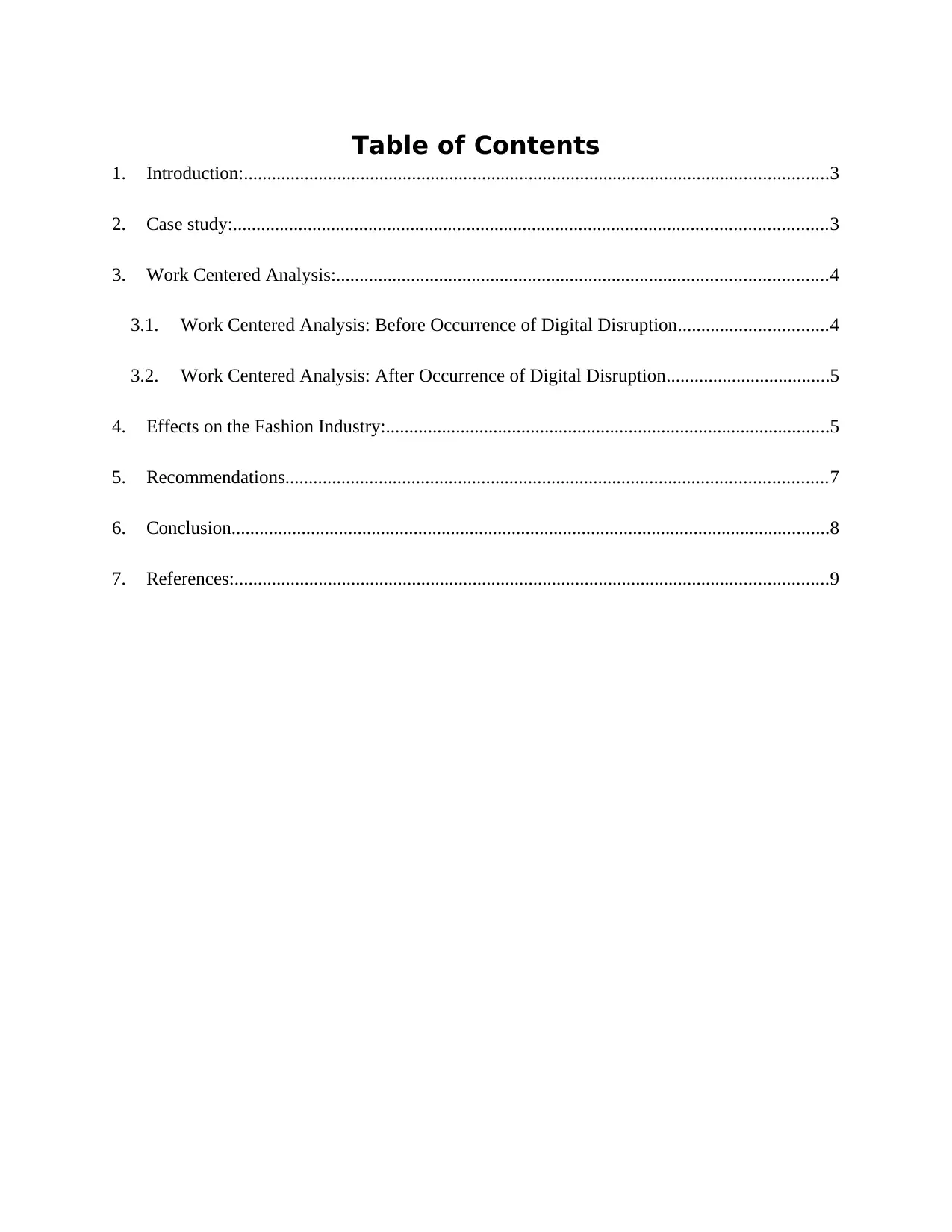
Table of Contents
1. Introduction:.............................................................................................................................3
2. Case study:...............................................................................................................................3
3. Work Centered Analysis:.........................................................................................................4
3.1. Work Centered Analysis: Before Occurrence of Digital Disruption................................4
3.2. Work Centered Analysis: After Occurrence of Digital Disruption...................................5
4. Effects on the Fashion Industry:...............................................................................................5
5. Recommendations....................................................................................................................7
6. Conclusion................................................................................................................................8
7. References:...............................................................................................................................9
1. Introduction:.............................................................................................................................3
2. Case study:...............................................................................................................................3
3. Work Centered Analysis:.........................................................................................................4
3.1. Work Centered Analysis: Before Occurrence of Digital Disruption................................4
3.2. Work Centered Analysis: After Occurrence of Digital Disruption...................................5
4. Effects on the Fashion Industry:...............................................................................................5
5. Recommendations....................................................................................................................7
6. Conclusion................................................................................................................................8
7. References:...............................................................................................................................9
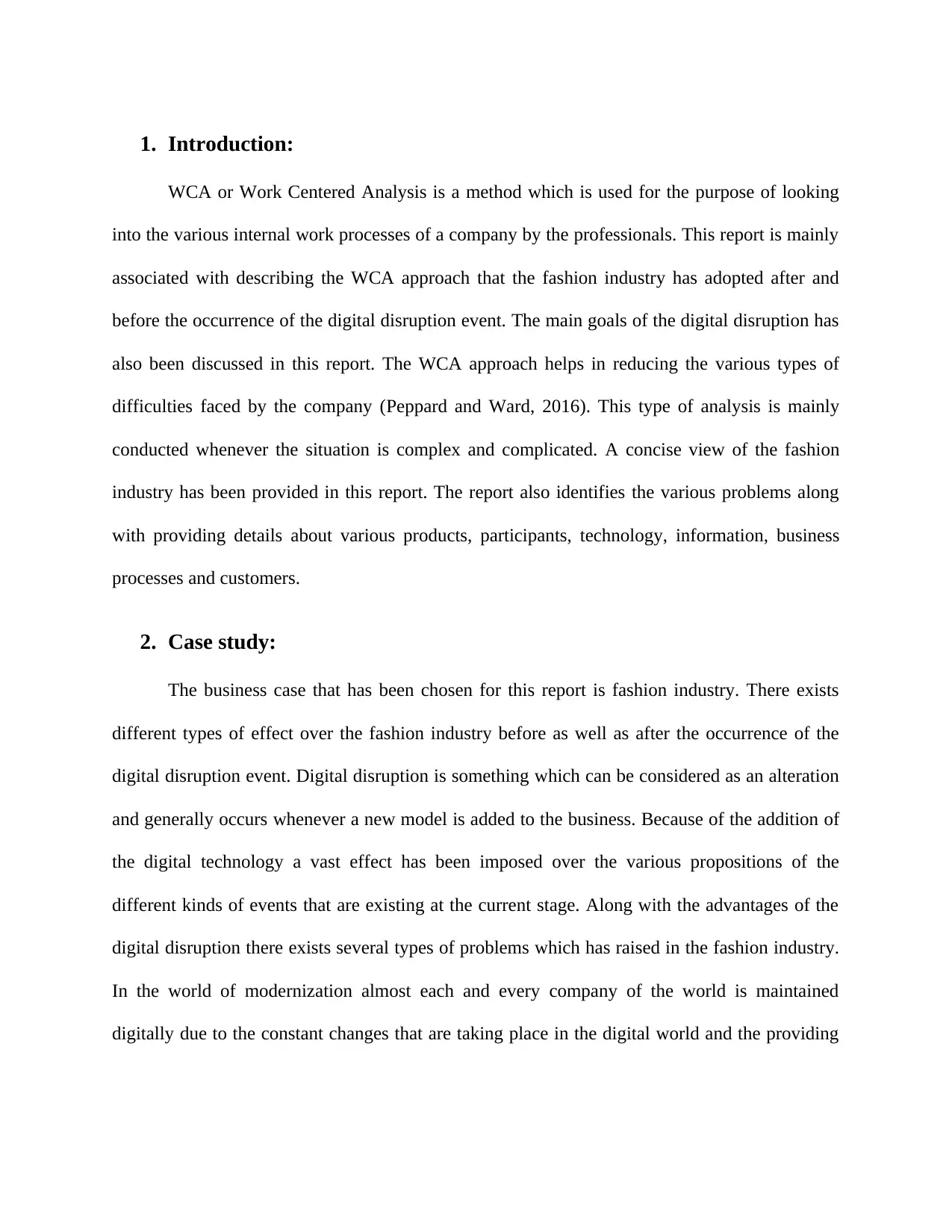
1. Introduction:
WCA or Work Centered Analysis is a method which is used for the purpose of looking
into the various internal work processes of a company by the professionals. This report is mainly
associated with describing the WCA approach that the fashion industry has adopted after and
before the occurrence of the digital disruption event. The main goals of the digital disruption has
also been discussed in this report. The WCA approach helps in reducing the various types of
difficulties faced by the company (Peppard and Ward, 2016). This type of analysis is mainly
conducted whenever the situation is complex and complicated. A concise view of the fashion
industry has been provided in this report. The report also identifies the various problems along
with providing details about various products, participants, technology, information, business
processes and customers.
2. Case study:
The business case that has been chosen for this report is fashion industry. There exists
different types of effect over the fashion industry before as well as after the occurrence of the
digital disruption event. Digital disruption is something which can be considered as an alteration
and generally occurs whenever a new model is added to the business. Because of the addition of
the digital technology a vast effect has been imposed over the various propositions of the
different kinds of events that are existing at the current stage. Along with the advantages of the
digital disruption there exists several types of problems which has raised in the fashion industry.
In the world of modernization almost each and every company of the world is maintained
digitally due to the constant changes that are taking place in the digital world and the providing
WCA or Work Centered Analysis is a method which is used for the purpose of looking
into the various internal work processes of a company by the professionals. This report is mainly
associated with describing the WCA approach that the fashion industry has adopted after and
before the occurrence of the digital disruption event. The main goals of the digital disruption has
also been discussed in this report. The WCA approach helps in reducing the various types of
difficulties faced by the company (Peppard and Ward, 2016). This type of analysis is mainly
conducted whenever the situation is complex and complicated. A concise view of the fashion
industry has been provided in this report. The report also identifies the various problems along
with providing details about various products, participants, technology, information, business
processes and customers.
2. Case study:
The business case that has been chosen for this report is fashion industry. There exists
different types of effect over the fashion industry before as well as after the occurrence of the
digital disruption event. Digital disruption is something which can be considered as an alteration
and generally occurs whenever a new model is added to the business. Because of the addition of
the digital technology a vast effect has been imposed over the various propositions of the
different kinds of events that are existing at the current stage. Along with the advantages of the
digital disruption there exists several types of problems which has raised in the fashion industry.
In the world of modernization almost each and every company of the world is maintained
digitally due to the constant changes that are taking place in the digital world and the providing
⊘ This is a preview!⊘
Do you want full access?
Subscribe today to unlock all pages.

Trusted by 1+ million students worldwide
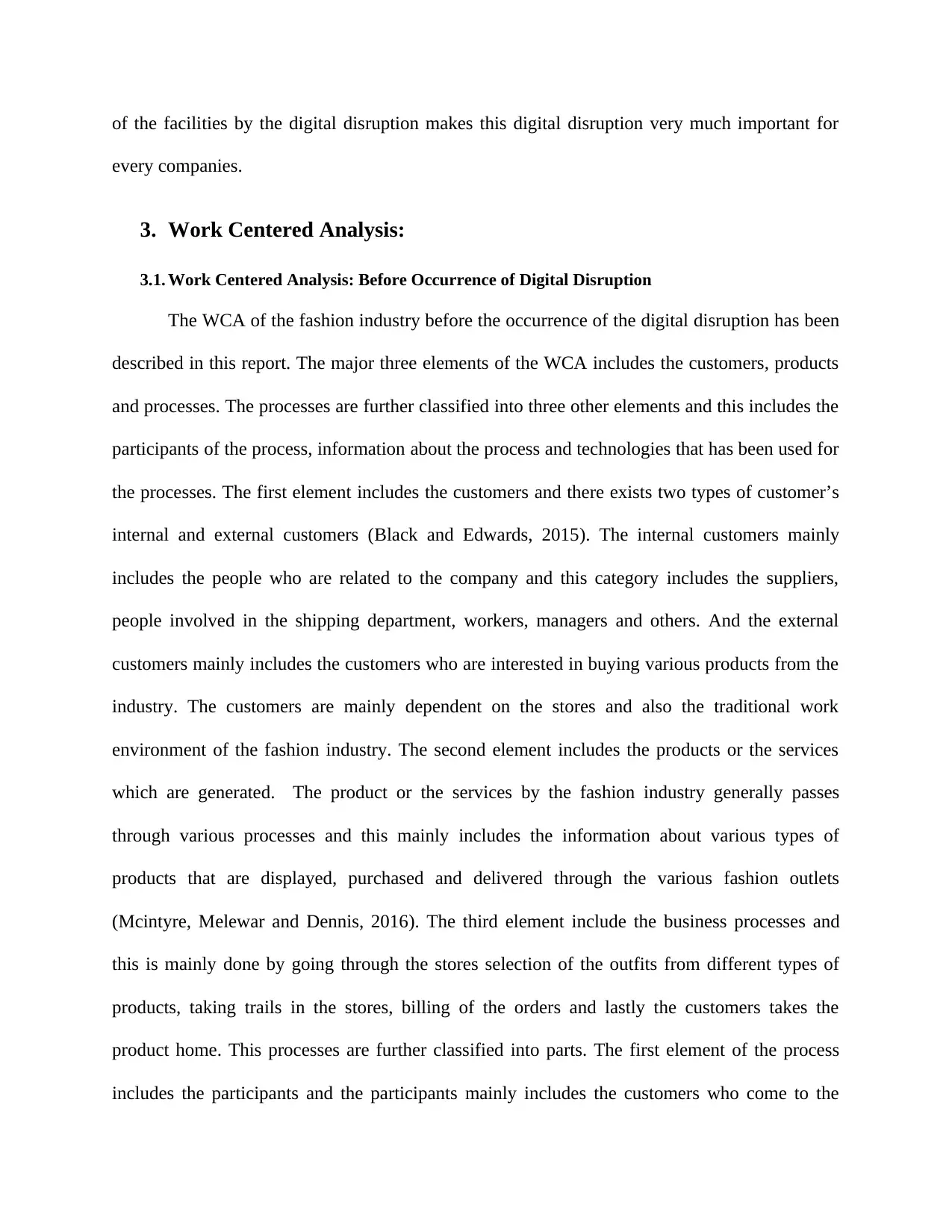
of the facilities by the digital disruption makes this digital disruption very much important for
every companies.
3. Work Centered Analysis:
3.1. Work Centered Analysis: Before Occurrence of Digital Disruption
The WCA of the fashion industry before the occurrence of the digital disruption has been
described in this report. The major three elements of the WCA includes the customers, products
and processes. The processes are further classified into three other elements and this includes the
participants of the process, information about the process and technologies that has been used for
the processes. The first element includes the customers and there exists two types of customer’s
internal and external customers (Black and Edwards, 2015). The internal customers mainly
includes the people who are related to the company and this category includes the suppliers,
people involved in the shipping department, workers, managers and others. And the external
customers mainly includes the customers who are interested in buying various products from the
industry. The customers are mainly dependent on the stores and also the traditional work
environment of the fashion industry. The second element includes the products or the services
which are generated. The product or the services by the fashion industry generally passes
through various processes and this mainly includes the information about various types of
products that are displayed, purchased and delivered through the various fashion outlets
(Mcintyre, Melewar and Dennis, 2016). The third element include the business processes and
this is mainly done by going through the stores selection of the outfits from different types of
products, taking trails in the stores, billing of the orders and lastly the customers takes the
product home. This processes are further classified into parts. The first element of the process
includes the participants and the participants mainly includes the customers who come to the
every companies.
3. Work Centered Analysis:
3.1. Work Centered Analysis: Before Occurrence of Digital Disruption
The WCA of the fashion industry before the occurrence of the digital disruption has been
described in this report. The major three elements of the WCA includes the customers, products
and processes. The processes are further classified into three other elements and this includes the
participants of the process, information about the process and technologies that has been used for
the processes. The first element includes the customers and there exists two types of customer’s
internal and external customers (Black and Edwards, 2015). The internal customers mainly
includes the people who are related to the company and this category includes the suppliers,
people involved in the shipping department, workers, managers and others. And the external
customers mainly includes the customers who are interested in buying various products from the
industry. The customers are mainly dependent on the stores and also the traditional work
environment of the fashion industry. The second element includes the products or the services
which are generated. The product or the services by the fashion industry generally passes
through various processes and this mainly includes the information about various types of
products that are displayed, purchased and delivered through the various fashion outlets
(Mcintyre, Melewar and Dennis, 2016). The third element include the business processes and
this is mainly done by going through the stores selection of the outfits from different types of
products, taking trails in the stores, billing of the orders and lastly the customers takes the
product home. This processes are further classified into parts. The first element of the process
includes the participants and the participants mainly includes the customers who come to the
Paraphrase This Document
Need a fresh take? Get an instant paraphrase of this document with our AI Paraphraser
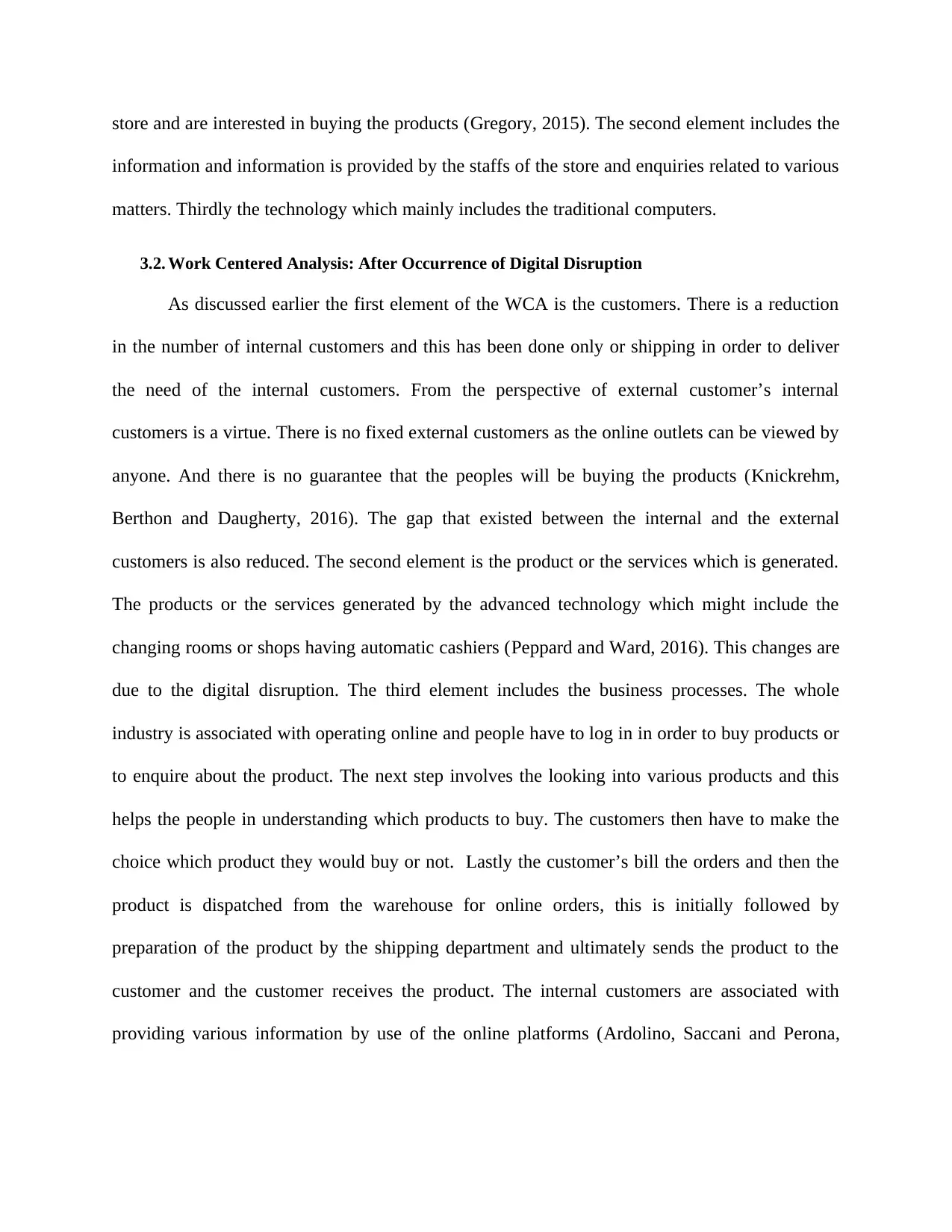
store and are interested in buying the products (Gregory, 2015). The second element includes the
information and information is provided by the staffs of the store and enquiries related to various
matters. Thirdly the technology which mainly includes the traditional computers.
3.2. Work Centered Analysis: After Occurrence of Digital Disruption
As discussed earlier the first element of the WCA is the customers. There is a reduction
in the number of internal customers and this has been done only or shipping in order to deliver
the need of the internal customers. From the perspective of external customer’s internal
customers is a virtue. There is no fixed external customers as the online outlets can be viewed by
anyone. And there is no guarantee that the peoples will be buying the products (Knickrehm,
Berthon and Daugherty, 2016). The gap that existed between the internal and the external
customers is also reduced. The second element is the product or the services which is generated.
The products or the services generated by the advanced technology which might include the
changing rooms or shops having automatic cashiers (Peppard and Ward, 2016). This changes are
due to the digital disruption. The third element includes the business processes. The whole
industry is associated with operating online and people have to log in in order to buy products or
to enquire about the product. The next step involves the looking into various products and this
helps the people in understanding which products to buy. The customers then have to make the
choice which product they would buy or not. Lastly the customer’s bill the orders and then the
product is dispatched from the warehouse for online orders, this is initially followed by
preparation of the product by the shipping department and ultimately sends the product to the
customer and the customer receives the product. The internal customers are associated with
providing various information by use of the online platforms (Ardolino, Saccani and Perona,
information and information is provided by the staffs of the store and enquiries related to various
matters. Thirdly the technology which mainly includes the traditional computers.
3.2. Work Centered Analysis: After Occurrence of Digital Disruption
As discussed earlier the first element of the WCA is the customers. There is a reduction
in the number of internal customers and this has been done only or shipping in order to deliver
the need of the internal customers. From the perspective of external customer’s internal
customers is a virtue. There is no fixed external customers as the online outlets can be viewed by
anyone. And there is no guarantee that the peoples will be buying the products (Knickrehm,
Berthon and Daugherty, 2016). The gap that existed between the internal and the external
customers is also reduced. The second element is the product or the services which is generated.
The products or the services generated by the advanced technology which might include the
changing rooms or shops having automatic cashiers (Peppard and Ward, 2016). This changes are
due to the digital disruption. The third element includes the business processes. The whole
industry is associated with operating online and people have to log in in order to buy products or
to enquire about the product. The next step involves the looking into various products and this
helps the people in understanding which products to buy. The customers then have to make the
choice which product they would buy or not. Lastly the customer’s bill the orders and then the
product is dispatched from the warehouse for online orders, this is initially followed by
preparation of the product by the shipping department and ultimately sends the product to the
customer and the customer receives the product. The internal customers are associated with
providing various information by use of the online platforms (Ardolino, Saccani and Perona,
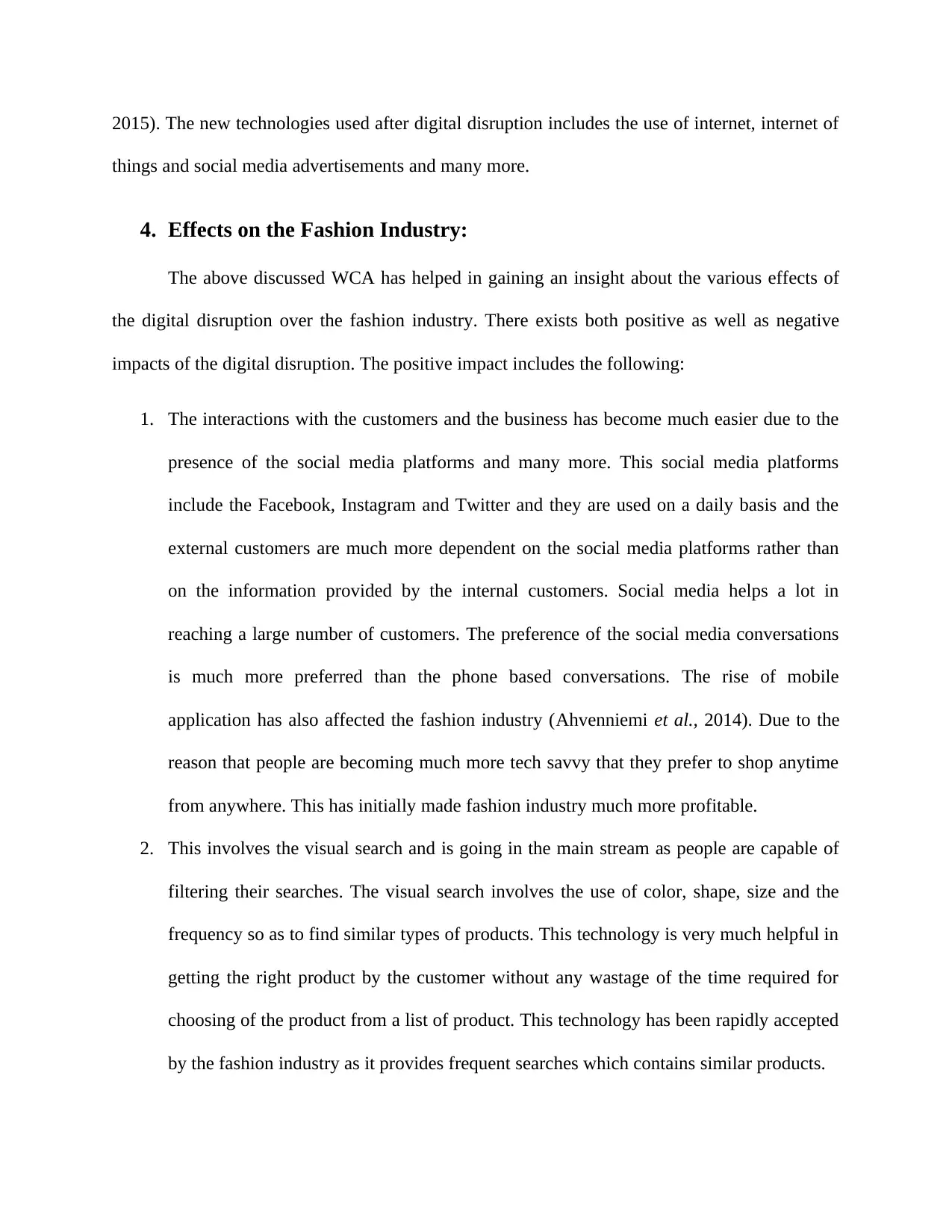
2015). The new technologies used after digital disruption includes the use of internet, internet of
things and social media advertisements and many more.
4. Effects on the Fashion Industry:
The above discussed WCA has helped in gaining an insight about the various effects of
the digital disruption over the fashion industry. There exists both positive as well as negative
impacts of the digital disruption. The positive impact includes the following:
1. The interactions with the customers and the business has become much easier due to the
presence of the social media platforms and many more. This social media platforms
include the Facebook, Instagram and Twitter and they are used on a daily basis and the
external customers are much more dependent on the social media platforms rather than
on the information provided by the internal customers. Social media helps a lot in
reaching a large number of customers. The preference of the social media conversations
is much more preferred than the phone based conversations. The rise of mobile
application has also affected the fashion industry (Ahvenniemi et al., 2014). Due to the
reason that people are becoming much more tech savvy that they prefer to shop anytime
from anywhere. This has initially made fashion industry much more profitable.
2. This involves the visual search and is going in the main stream as people are capable of
filtering their searches. The visual search involves the use of color, shape, size and the
frequency so as to find similar types of products. This technology is very much helpful in
getting the right product by the customer without any wastage of the time required for
choosing of the product from a list of product. This technology has been rapidly accepted
by the fashion industry as it provides frequent searches which contains similar products.
things and social media advertisements and many more.
4. Effects on the Fashion Industry:
The above discussed WCA has helped in gaining an insight about the various effects of
the digital disruption over the fashion industry. There exists both positive as well as negative
impacts of the digital disruption. The positive impact includes the following:
1. The interactions with the customers and the business has become much easier due to the
presence of the social media platforms and many more. This social media platforms
include the Facebook, Instagram and Twitter and they are used on a daily basis and the
external customers are much more dependent on the social media platforms rather than
on the information provided by the internal customers. Social media helps a lot in
reaching a large number of customers. The preference of the social media conversations
is much more preferred than the phone based conversations. The rise of mobile
application has also affected the fashion industry (Ahvenniemi et al., 2014). Due to the
reason that people are becoming much more tech savvy that they prefer to shop anytime
from anywhere. This has initially made fashion industry much more profitable.
2. This involves the visual search and is going in the main stream as people are capable of
filtering their searches. The visual search involves the use of color, shape, size and the
frequency so as to find similar types of products. This technology is very much helpful in
getting the right product by the customer without any wastage of the time required for
choosing of the product from a list of product. This technology has been rapidly accepted
by the fashion industry as it provides frequent searches which contains similar products.
⊘ This is a preview!⊘
Do you want full access?
Subscribe today to unlock all pages.

Trusted by 1+ million students worldwide
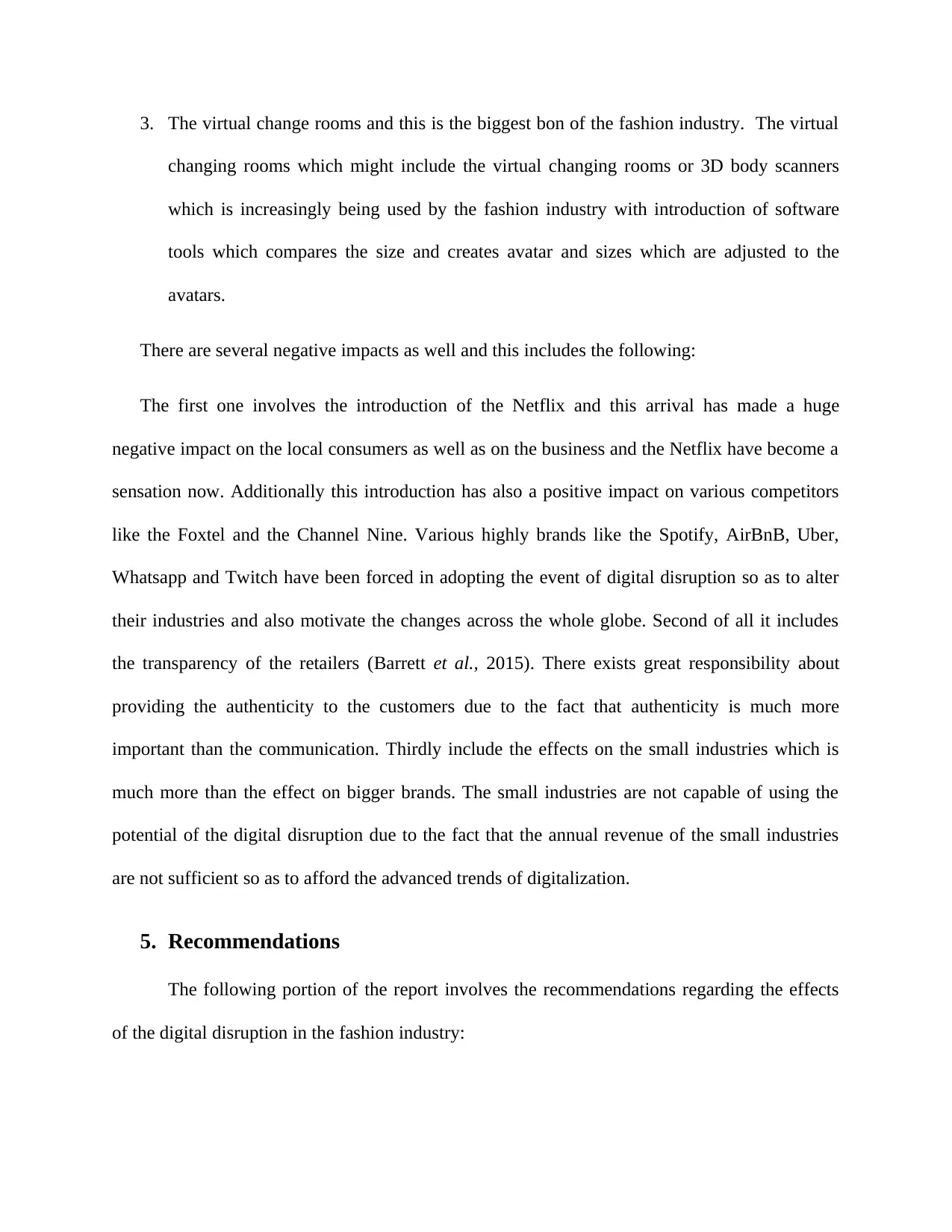
3. The virtual change rooms and this is the biggest bon of the fashion industry. The virtual
changing rooms which might include the virtual changing rooms or 3D body scanners
which is increasingly being used by the fashion industry with introduction of software
tools which compares the size and creates avatar and sizes which are adjusted to the
avatars.
There are several negative impacts as well and this includes the following:
The first one involves the introduction of the Netflix and this arrival has made a huge
negative impact on the local consumers as well as on the business and the Netflix have become a
sensation now. Additionally this introduction has also a positive impact on various competitors
like the Foxtel and the Channel Nine. Various highly brands like the Spotify, AirBnB, Uber,
Whatsapp and Twitch have been forced in adopting the event of digital disruption so as to alter
their industries and also motivate the changes across the whole globe. Second of all it includes
the transparency of the retailers (Barrett et al., 2015). There exists great responsibility about
providing the authenticity to the customers due to the fact that authenticity is much more
important than the communication. Thirdly include the effects on the small industries which is
much more than the effect on bigger brands. The small industries are not capable of using the
potential of the digital disruption due to the fact that the annual revenue of the small industries
are not sufficient so as to afford the advanced trends of digitalization.
5. Recommendations
The following portion of the report involves the recommendations regarding the effects
of the digital disruption in the fashion industry:
changing rooms which might include the virtual changing rooms or 3D body scanners
which is increasingly being used by the fashion industry with introduction of software
tools which compares the size and creates avatar and sizes which are adjusted to the
avatars.
There are several negative impacts as well and this includes the following:
The first one involves the introduction of the Netflix and this arrival has made a huge
negative impact on the local consumers as well as on the business and the Netflix have become a
sensation now. Additionally this introduction has also a positive impact on various competitors
like the Foxtel and the Channel Nine. Various highly brands like the Spotify, AirBnB, Uber,
Whatsapp and Twitch have been forced in adopting the event of digital disruption so as to alter
their industries and also motivate the changes across the whole globe. Second of all it includes
the transparency of the retailers (Barrett et al., 2015). There exists great responsibility about
providing the authenticity to the customers due to the fact that authenticity is much more
important than the communication. Thirdly include the effects on the small industries which is
much more than the effect on bigger brands. The small industries are not capable of using the
potential of the digital disruption due to the fact that the annual revenue of the small industries
are not sufficient so as to afford the advanced trends of digitalization.
5. Recommendations
The following portion of the report involves the recommendations regarding the effects
of the digital disruption in the fashion industry:
Paraphrase This Document
Need a fresh take? Get an instant paraphrase of this document with our AI Paraphraser
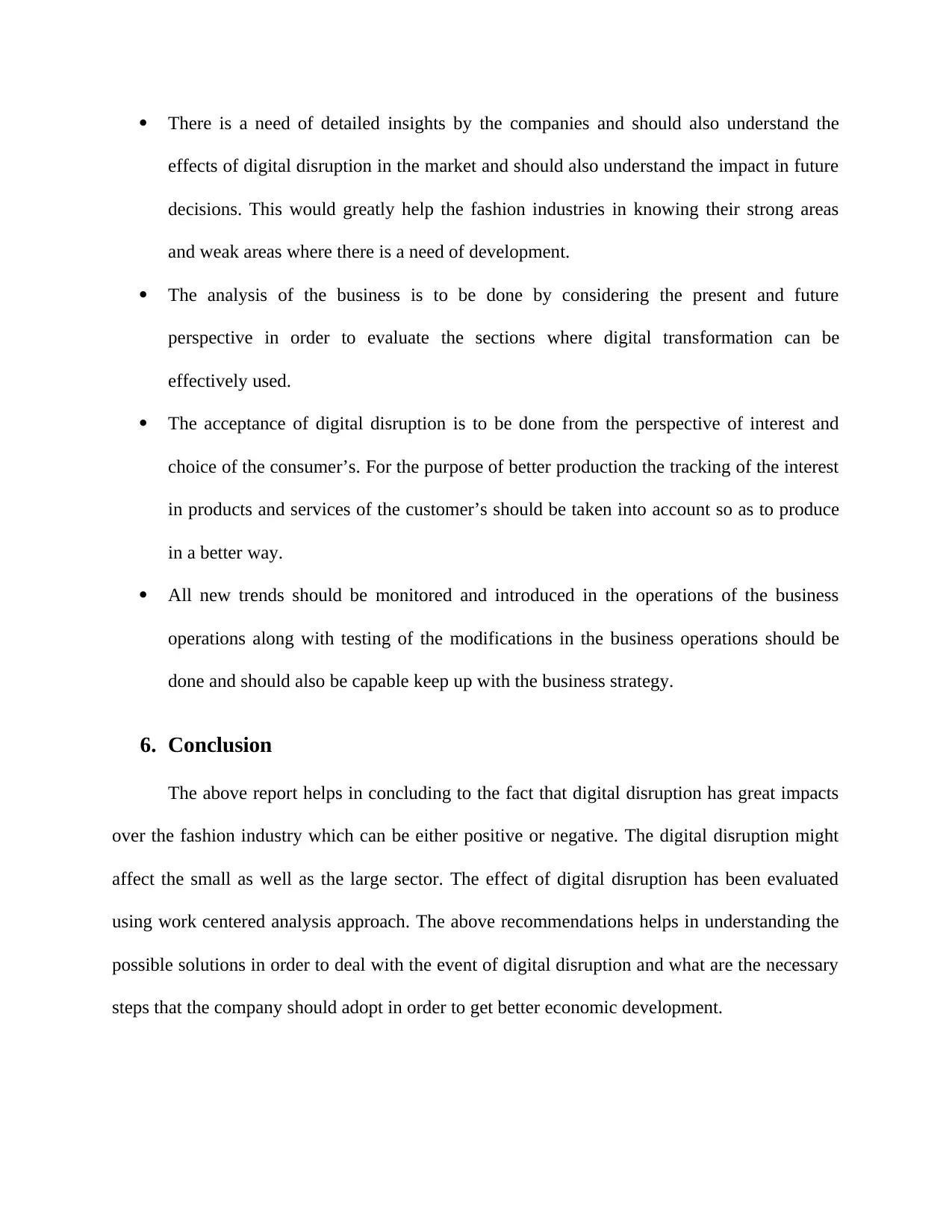
There is a need of detailed insights by the companies and should also understand the
effects of digital disruption in the market and should also understand the impact in future
decisions. This would greatly help the fashion industries in knowing their strong areas
and weak areas where there is a need of development.
The analysis of the business is to be done by considering the present and future
perspective in order to evaluate the sections where digital transformation can be
effectively used.
The acceptance of digital disruption is to be done from the perspective of interest and
choice of the consumer’s. For the purpose of better production the tracking of the interest
in products and services of the customer’s should be taken into account so as to produce
in a better way.
All new trends should be monitored and introduced in the operations of the business
operations along with testing of the modifications in the business operations should be
done and should also be capable keep up with the business strategy.
6. Conclusion
The above report helps in concluding to the fact that digital disruption has great impacts
over the fashion industry which can be either positive or negative. The digital disruption might
affect the small as well as the large sector. The effect of digital disruption has been evaluated
using work centered analysis approach. The above recommendations helps in understanding the
possible solutions in order to deal with the event of digital disruption and what are the necessary
steps that the company should adopt in order to get better economic development.
effects of digital disruption in the market and should also understand the impact in future
decisions. This would greatly help the fashion industries in knowing their strong areas
and weak areas where there is a need of development.
The analysis of the business is to be done by considering the present and future
perspective in order to evaluate the sections where digital transformation can be
effectively used.
The acceptance of digital disruption is to be done from the perspective of interest and
choice of the consumer’s. For the purpose of better production the tracking of the interest
in products and services of the customer’s should be taken into account so as to produce
in a better way.
All new trends should be monitored and introduced in the operations of the business
operations along with testing of the modifications in the business operations should be
done and should also be capable keep up with the business strategy.
6. Conclusion
The above report helps in concluding to the fact that digital disruption has great impacts
over the fashion industry which can be either positive or negative. The digital disruption might
affect the small as well as the large sector. The effect of digital disruption has been evaluated
using work centered analysis approach. The above recommendations helps in understanding the
possible solutions in order to deal with the event of digital disruption and what are the necessary
steps that the company should adopt in order to get better economic development.
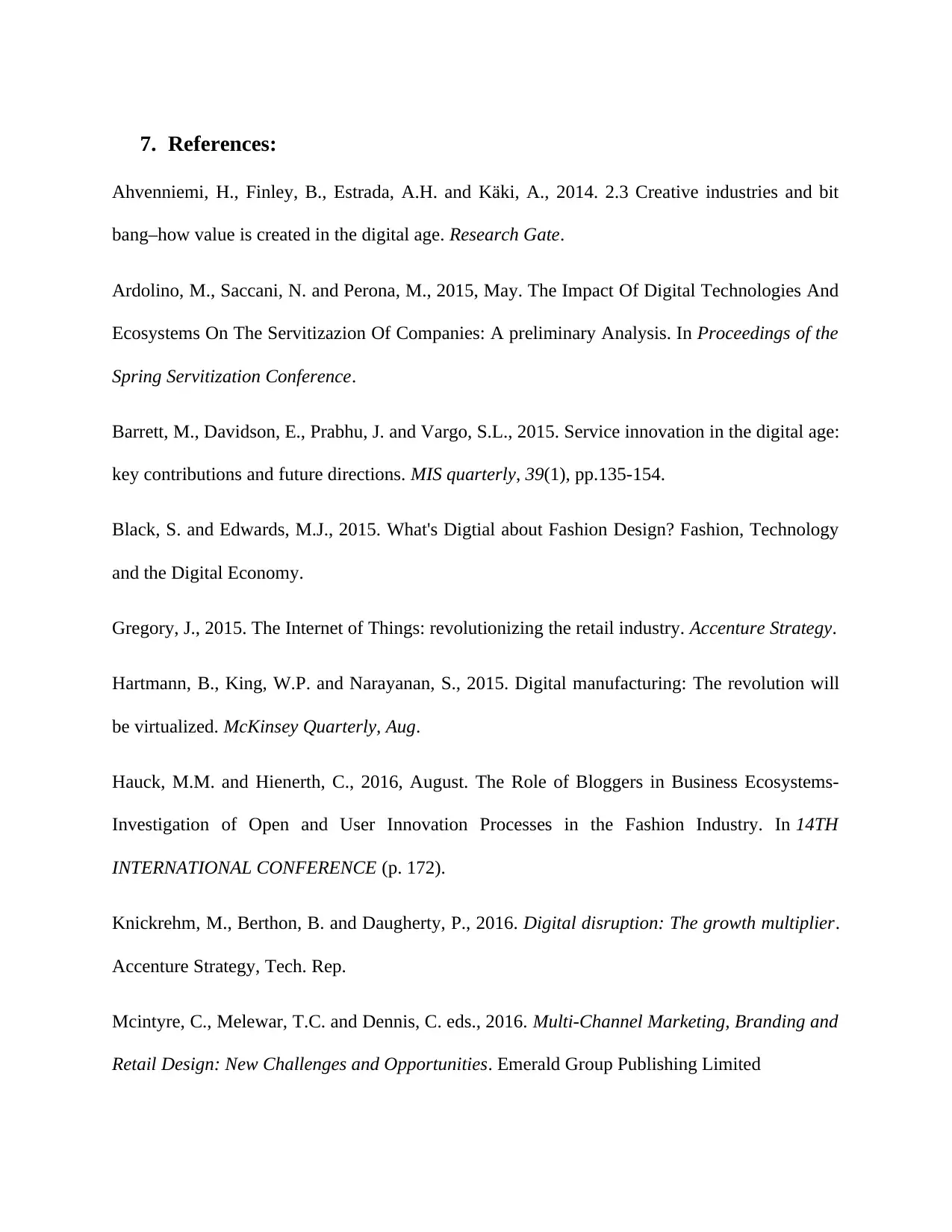
7. References:
Ahvenniemi, H., Finley, B., Estrada, A.H. and Käki, A., 2014. 2.3 Creative industries and bit
bang–how value is created in the digital age. Research Gate.
Ardolino, M., Saccani, N. and Perona, M., 2015, May. The Impact Of Digital Technologies And
Ecosystems On The Servitizazion Of Companies: A preliminary Analysis. In Proceedings of the
Spring Servitization Conference.
Barrett, M., Davidson, E., Prabhu, J. and Vargo, S.L., 2015. Service innovation in the digital age:
key contributions and future directions. MIS quarterly, 39(1), pp.135-154.
Black, S. and Edwards, M.J., 2015. What's Digtial about Fashion Design? Fashion, Technology
and the Digital Economy.
Gregory, J., 2015. The Internet of Things: revolutionizing the retail industry. Accenture Strategy.
Hartmann, B., King, W.P. and Narayanan, S., 2015. Digital manufacturing: The revolution will
be virtualized. McKinsey Quarterly, Aug.
Hauck, M.M. and Hienerth, C., 2016, August. The Role of Bloggers in Business Ecosystems-
Investigation of Open and User Innovation Processes in the Fashion Industry. In 14TH
INTERNATIONAL CONFERENCE (p. 172).
Knickrehm, M., Berthon, B. and Daugherty, P., 2016. Digital disruption: The growth multiplier.
Accenture Strategy, Tech. Rep.
Mcintyre, C., Melewar, T.C. and Dennis, C. eds., 2016. Multi-Channel Marketing, Branding and
Retail Design: New Challenges and Opportunities. Emerald Group Publishing Limited
Ahvenniemi, H., Finley, B., Estrada, A.H. and Käki, A., 2014. 2.3 Creative industries and bit
bang–how value is created in the digital age. Research Gate.
Ardolino, M., Saccani, N. and Perona, M., 2015, May. The Impact Of Digital Technologies And
Ecosystems On The Servitizazion Of Companies: A preliminary Analysis. In Proceedings of the
Spring Servitization Conference.
Barrett, M., Davidson, E., Prabhu, J. and Vargo, S.L., 2015. Service innovation in the digital age:
key contributions and future directions. MIS quarterly, 39(1), pp.135-154.
Black, S. and Edwards, M.J., 2015. What's Digtial about Fashion Design? Fashion, Technology
and the Digital Economy.
Gregory, J., 2015. The Internet of Things: revolutionizing the retail industry. Accenture Strategy.
Hartmann, B., King, W.P. and Narayanan, S., 2015. Digital manufacturing: The revolution will
be virtualized. McKinsey Quarterly, Aug.
Hauck, M.M. and Hienerth, C., 2016, August. The Role of Bloggers in Business Ecosystems-
Investigation of Open and User Innovation Processes in the Fashion Industry. In 14TH
INTERNATIONAL CONFERENCE (p. 172).
Knickrehm, M., Berthon, B. and Daugherty, P., 2016. Digital disruption: The growth multiplier.
Accenture Strategy, Tech. Rep.
Mcintyre, C., Melewar, T.C. and Dennis, C. eds., 2016. Multi-Channel Marketing, Branding and
Retail Design: New Challenges and Opportunities. Emerald Group Publishing Limited
⊘ This is a preview!⊘
Do you want full access?
Subscribe today to unlock all pages.

Trusted by 1+ million students worldwide
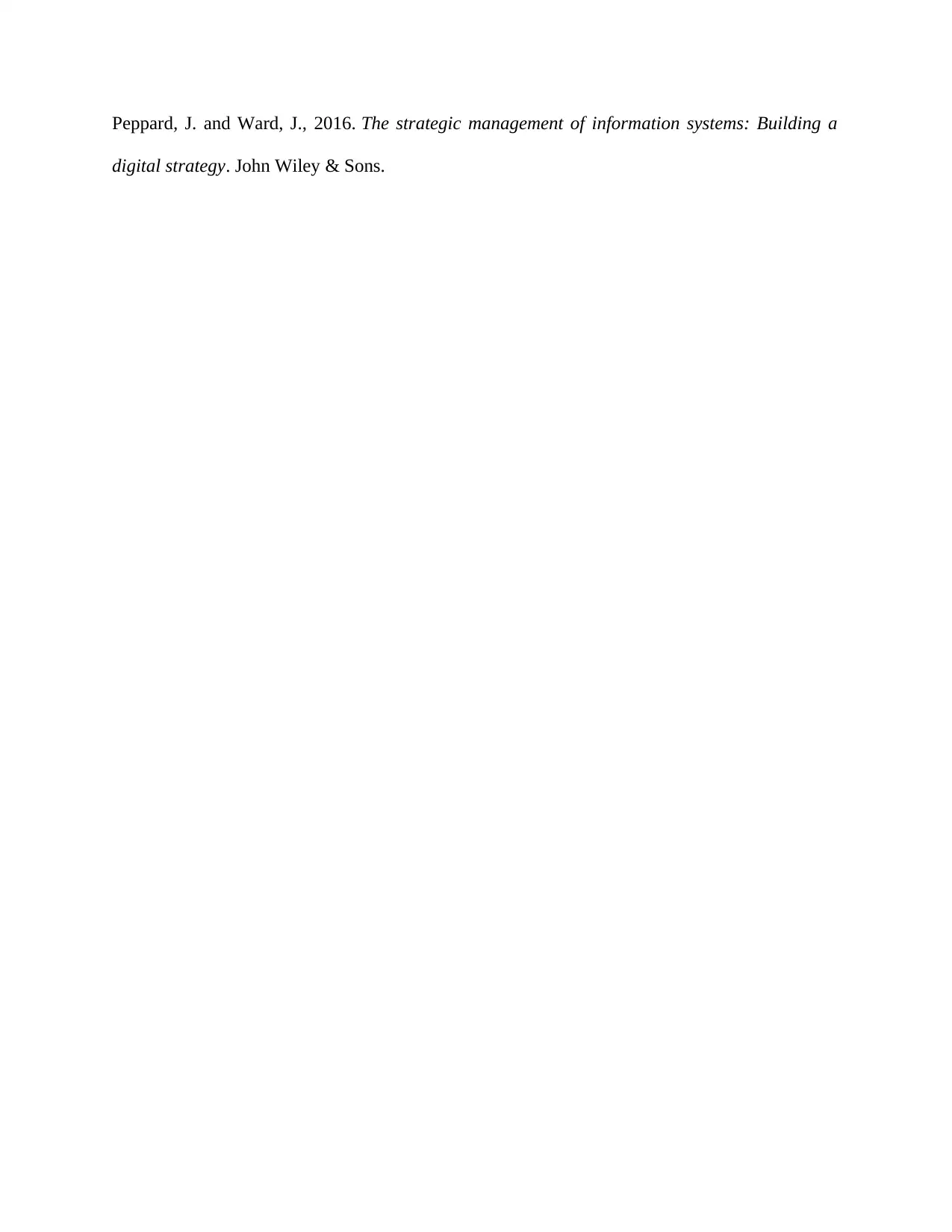
Peppard, J. and Ward, J., 2016. The strategic management of information systems: Building a
digital strategy. John Wiley & Sons.
digital strategy. John Wiley & Sons.
1 out of 10
Related Documents
Your All-in-One AI-Powered Toolkit for Academic Success.
+13062052269
info@desklib.com
Available 24*7 on WhatsApp / Email
![[object Object]](/_next/static/media/star-bottom.7253800d.svg)
Unlock your academic potential
Copyright © 2020–2025 A2Z Services. All Rights Reserved. Developed and managed by ZUCOL.




